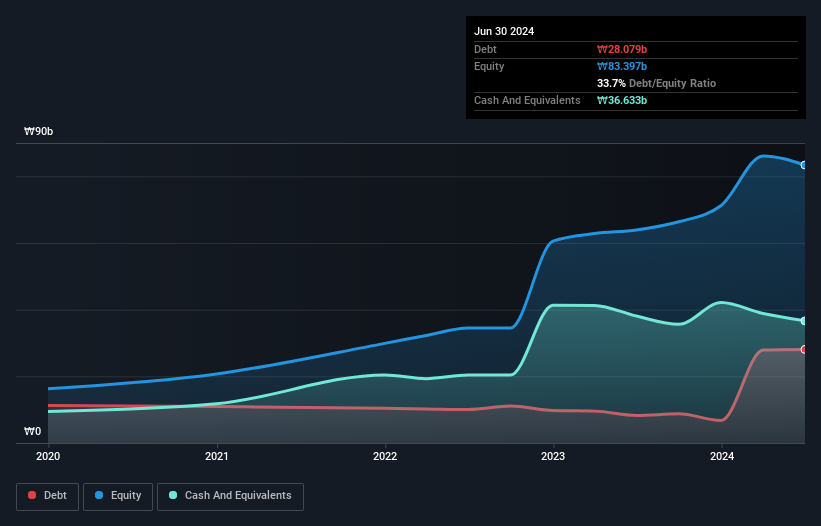Warren Buffett famously said, 'Volatility is far from synonymous with risk.' It's only natural to consider a company's balance sheet when you examine how risky it is, since debt is often involved when a business collapses. As with many other companies Tfe Inc. (KOSDAQ:425420) makes use of debt. But the more important question is: how much risk is that debt creating?
Why Does Debt Bring Risk?
Debt and other liabilities become risky for a business when it cannot easily fulfill those obligations, either with free cash flow or by raising capital at an attractive price. Ultimately, if the company can't fulfill its legal obligations to repay debt, shareholders could walk away with nothing. While that is not too common, we often do see indebted companies permanently diluting shareholders because lenders force them to raise capital at a distressed price. By replacing dilution, though, debt can be an extremely good tool for businesses that need capital to invest in growth at high rates of return. The first step when considering a company's debt levels is to consider its cash and debt together.
View our latest analysis for Tfe
What Is Tfe's Net Debt?
As you can see below, at the end of June 2024, Tfe had ₩28.1b of debt, up from ₩8.27b a year ago. Click the image for more detail. However, its balance sheet shows it holds ₩36.6b in cash, so it actually has ₩8.55b net cash.

A Look At Tfe's Liabilities
The latest balance sheet data shows that Tfe had liabilities of ₩14.5b due within a year, and liabilities of ₩33.6b falling due after that. Offsetting these obligations, it had cash of ₩36.6b as well as receivables valued at ₩8.65b due within 12 months. So it has liabilities totalling ₩2.84b more than its cash and near-term receivables, combined.
Having regard to Tfe's size, it seems that its liquid assets are well balanced with its total liabilities. So while it's hard to imagine that the ₩219.3b company is struggling for cash, we still think it's worth monitoring its balance sheet. While it does have liabilities worth noting, Tfe also has more cash than debt, so we're pretty confident it can manage its debt safely.
On top of that, Tfe grew its EBIT by 93% over the last twelve months, and that growth will make it easier to handle its debt. There's no doubt that we learn most about debt from the balance sheet. But it is Tfe's earnings that will influence how the balance sheet holds up in the future. So if you're keen to discover more about its earnings, it might be worth checking out this graph of its long term earnings trend.
Finally, while the tax-man may adore accounting profits, lenders only accept cold hard cash. Tfe may have net cash on the balance sheet, but it is still interesting to look at how well the business converts its earnings before interest and tax (EBIT) to free cash flow, because that will influence both its need for, and its capacity to manage debt. Over the last three years, Tfe recorded negative free cash flow, in total. Debt is usually more expensive, and almost always more risky in the hands of a company with negative free cash flow. Shareholders ought to hope for an improvement.
Summing Up
We could understand if investors are concerned about Tfe's liabilities, but we can be reassured by the fact it has has net cash of ₩8.55b. And we liked the look of last year's 93% year-on-year EBIT growth. So we don't have any problem with Tfe's use of debt. When analysing debt levels, the balance sheet is the obvious place to start. But ultimately, every company can contain risks that exist outside of the balance sheet. For example Tfe has 2 warning signs (and 1 which shouldn't be ignored) we think you should know about.
At the end of the day, it's often better to focus on companies that are free from net debt. You can access our special list of such companies (all with a track record of profit growth). It's free.
Valuation is complex, but we're here to simplify it.
Discover if Tfe might be undervalued or overvalued with our detailed analysis, featuring fair value estimates, potential risks, dividends, insider trades, and its financial condition.
Access Free AnalysisHave feedback on this article? Concerned about the content? Get in touch with us directly. Alternatively, email editorial-team (at) simplywallst.com.
This article by Simply Wall St is general in nature. We provide commentary based on historical data and analyst forecasts only using an unbiased methodology and our articles are not intended to be financial advice. It does not constitute a recommendation to buy or sell any stock, and does not take account of your objectives, or your financial situation. We aim to bring you long-term focused analysis driven by fundamental data. Note that our analysis may not factor in the latest price-sensitive company announcements or qualitative material. Simply Wall St has no position in any stocks mentioned.
About KOSDAQ:A425420
Tfe
Engages in the manufacture and sale of semiconductor IC testing equipment in South Korea and internationally.
High growth potential with excellent balance sheet.
Similar Companies
Market Insights
Community Narratives



